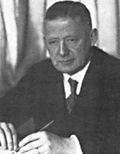Nationality German Role Geologist | Name Hans Stille | |
 | ||
Born October 8, 1876Hanover, Germany ( 1876-10-08 ) Institutions University of GottingenHumboldt University of Berlin Notable awards Gustav-Steinmann-Medaille (1951) Institution University of Gottingen, Humboldt University of Berlin | ||
Hans Wilhelm Stille (October 8, 1876 – December 26, 1966) was an influential German geologist working primarily on tectonics and the collation of tectonic events during the Phanerozoic.
Contents
Early life and education
He was born in Hanover, Germany, and was educated in Göttingen. For his graduate studies he studied mountain building in the region of the Teutoburg Forest.
Career
After graduation he served with the royal Prussian geological institute, making photographic surveys. His work would influence his future career, as he focused on tectonics.
Hans Stille served as professor of geology at the University of Göttingen. Working from the University of Göttingen and, later, the University of Berlin, Stille brought together a table of around 50 geosynchronous orogenic phases that occurred during the Phanerozoic Eon. In the framework developed by Stille, these phases occurred as small pulses during which a portion of the Earth's crust was stabilised, and the continents were enlarged. In 1924 he suggested a tectonic model for the continents that postulated alternating periods of orogenic (mountain building) and epeirogenic (no mountain building) episodes.
Further work studying internal details of the crust led Stille to expand the geosyncline concept. This useful synthesis of geological theory persisted until the mid-20th century, but was ultimately supplanted by plate tectonics. As well as providing a better explanation of tectonic events, this also undermined Stille's notion of globally correlated phases of orogeny. Notably, seafloor spreading, the mechanism driving what Stille had come to call geosyncline cycles, was only established as such in the year of his death.
He would introduce the term craton into the geologic vocabulary in 1933 that was used to describe those portions of the continental crust that were old and stable. The Geotectonic Research journal was founded in 1937 by Hans Stille and Franz Lotze.
Awards and honours
The Hans-Stille-Medaille of German Geological Society, awarded annually, is named after him. Also named for him is the mineral stilleite (ZnSe) and the wrinkle ridge Dorsa Stille on the Moon.
